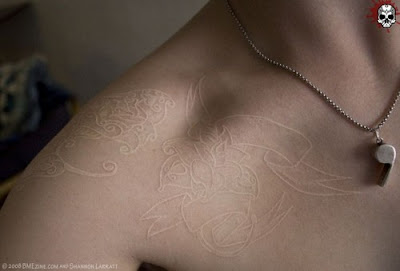
One of the most popular tattoo designs today is the white ink tattoo, which, as its name implies, is a tattoo colored exclusively with white pigment. While this definition is simple and straight forward, this style of tattoo is anything but average and has a lot of conditions that make them a great choice for some, but not so good for others.

Before getting into the specifics, it best to understand what this style of tattoo looks like compared to traditional designs. White ink is thicker than other pigments, and void of color, so the image will be raised on the skin and appear more as a scar, or brand, rather than your average tattoo. This unique look can be very distinctive and effective without the pain and healing time of a brand.

Now that you know what to expect from this type of tattoo, there are several factors that are important to know to see if they are right for you. The most important is that white pigment shows best on a light or fair complexion. If you have darker skin, the tattoo will appear transparent rather than a solid color, and if you have a lot of freckles, the image will appear uneven or speckled.

White ink shouldn't be combined with a colored design because the other colors will bleed into the white ink, distorting the image. They are also much more sensitive to sun damage and can fade to a yellowish color, or even totally disappear. Because of this you can expect a trip or two back to your artist for a touch up to maintain its original look.

Something else to think about is white pigment is harder to remove, and requires more trips to a tattoo removal specialist than a colored image, and at several hundred dollars a visit, can become very costly. The primary advantage of a white ink tattoo is its unique look, subtle but distinctive, often appearing as a brand, but capable of more intricate detail and the added dimensional advantage of the slightly raised skin.

When a white ink tattoo is first applied, it may appear puffy and unclear, and might have a strange yellowish color on account of lymph fluids entering the wound to help it heal. This is perfectly normal and happens in all tattoos, but more visible because of the contrast of the white color ink.

Follow normal aftercare directions and in a few weeks your new tattoo should look great. If you do suspect a problem or are unhappy with the outcome, take a trip back to your artist to address your concerns. On final note: When searching for a tattoo artist, ask for someone who is experienced in white ink tattoos, ask them if you are a good candidate, and make sure they are going to use pure white ink, and as always, ask to see examples of their work.
 One of the most popular tattoo designs today is the white ink tattoo, which, as its name implies, is a tattoo colored exclusively with white pigment. While this definition is simple and straight forward, this style of tattoo is anything but average and has a lot of conditions that make them a great choice for some, but not so good for others.
One of the most popular tattoo designs today is the white ink tattoo, which, as its name implies, is a tattoo colored exclusively with white pigment. While this definition is simple and straight forward, this style of tattoo is anything but average and has a lot of conditions that make them a great choice for some, but not so good for others. Before getting into the specifics, it best to understand what this style of tattoo looks like compared to traditional designs. White ink is thicker than other pigments, and void of color, so the image will be raised on the skin and appear more as a scar, or brand, rather than your average tattoo. This unique look can be very distinctive and effective without the pain and healing time of a brand.
Before getting into the specifics, it best to understand what this style of tattoo looks like compared to traditional designs. White ink is thicker than other pigments, and void of color, so the image will be raised on the skin and appear more as a scar, or brand, rather than your average tattoo. This unique look can be very distinctive and effective without the pain and healing time of a brand. Now that you know what to expect from this type of tattoo, there are several factors that are important to know to see if they are right for you. The most important is that white pigment shows best on a light or fair complexion. If you have darker skin, the tattoo will appear transparent rather than a solid color, and if you have a lot of freckles, the image will appear uneven or speckled.
Now that you know what to expect from this type of tattoo, there are several factors that are important to know to see if they are right for you. The most important is that white pigment shows best on a light or fair complexion. If you have darker skin, the tattoo will appear transparent rather than a solid color, and if you have a lot of freckles, the image will appear uneven or speckled. White ink shouldn't be combined with a colored design because the other colors will bleed into the white ink, distorting the image. They are also much more sensitive to sun damage and can fade to a yellowish color, or even totally disappear. Because of this you can expect a trip or two back to your artist for a touch up to maintain its original look.
White ink shouldn't be combined with a colored design because the other colors will bleed into the white ink, distorting the image. They are also much more sensitive to sun damage and can fade to a yellowish color, or even totally disappear. Because of this you can expect a trip or two back to your artist for a touch up to maintain its original look. Something else to think about is white pigment is harder to remove, and requires more trips to a tattoo removal specialist than a colored image, and at several hundred dollars a visit, can become very costly. The primary advantage of a white ink tattoo is its unique look, subtle but distinctive, often appearing as a brand, but capable of more intricate detail and the added dimensional advantage of the slightly raised skin.
Something else to think about is white pigment is harder to remove, and requires more trips to a tattoo removal specialist than a colored image, and at several hundred dollars a visit, can become very costly. The primary advantage of a white ink tattoo is its unique look, subtle but distinctive, often appearing as a brand, but capable of more intricate detail and the added dimensional advantage of the slightly raised skin. When a white ink tattoo is first applied, it may appear puffy and unclear, and might have a strange yellowish color on account of lymph fluids entering the wound to help it heal. This is perfectly normal and happens in all tattoos, but more visible because of the contrast of the white color ink.
When a white ink tattoo is first applied, it may appear puffy and unclear, and might have a strange yellowish color on account of lymph fluids entering the wound to help it heal. This is perfectly normal and happens in all tattoos, but more visible because of the contrast of the white color ink. Follow normal aftercare directions and in a few weeks your new tattoo should look great. If you do suspect a problem or are unhappy with the outcome, take a trip back to your artist to address your concerns. On final note: When searching for a tattoo artist, ask for someone who is experienced in white ink tattoos, ask them if you are a good candidate, and make sure they are going to use pure white ink, and as always, ask to see examples of their work.
Follow normal aftercare directions and in a few weeks your new tattoo should look great. If you do suspect a problem or are unhappy with the outcome, take a trip back to your artist to address your concerns. On final note: When searching for a tattoo artist, ask for someone who is experienced in white ink tattoos, ask them if you are a good candidate, and make sure they are going to use pure white ink, and as always, ask to see examples of their work.







No comments:
Post a Comment